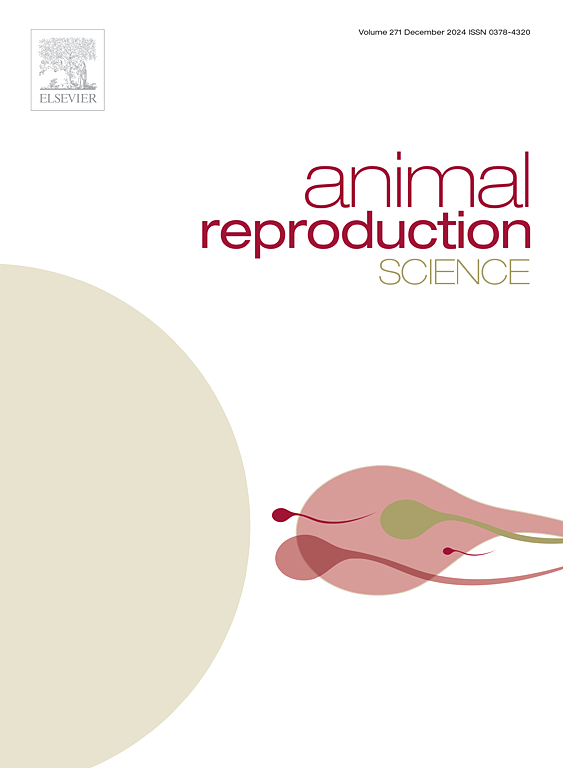Protective effect of supplementation with water soluble β-carotene and α-tocopherol in boar sperm cooling-freezing extender, but not in the thawing extender
IF 2.2
2区 农林科学
Q1 AGRICULTURE, DAIRY & ANIMAL SCIENCE
引用次数: 0
Abstract
Cryopreservation of sperm is a crucial tool for the long-term preservation of male genetic material, causing significant issues in motility, membrane, and acrosome integrity, among other parameters. Antioxidants have been used to cope with these detrimental effects. We tested 1. the toxicity of a wide range of water soluble β-carotene (β: 250–4000 µM) and α-tocopherol (α: 31–496 µM) concentrations on boar ejaculated sperm (n = 6) in parameters as motility, viability, acrosome reaction, apoptosis, oxidation, mitochondrial activation and membrane potential; 2. the effect of various β-carotene (250–1000 µM) and α-tocopherol (31–124 µM) concentrations added to the cooling-freezing or thawing extenders (n = 30) before (0 min) and after 90 min incubation (37 °C). Toxicity results showed a decrease in the proportion of live spermatozoa with non-reacted acrosome from 75.1 ± 3.3 % using β250/α31 to 60.1 ± 5.7 % and 59.3 ± 5.4 % in samples with β2000/α248 and β4000/α496 respectively (p < 0.05), suggesting a detrimental effect of the highest concentrations. Antioxidant supplementation in the cooling-freezing extender decreased the apoptotic and oxidized spermatozoa in β500/α62 and β1000/α124, relative to the control. In contrast, antioxidants addition to the thawing extender induced some detrimental effects in several sperm parameters analyzed. In conclusion, water-soluble β-carotene and α-tocopherol prevent acrosome reaction and oxidation during cooling-freezing on boar sperm. High concentrations of these antioxidants negatively impacted motility and mitochondrial function, suggesting cytotoxic effects and potential capacitation-like changes. The β1000/α124 showed protective effects during cryopreservation, but post-thawing supplementation may stimulate oxidative stress rather than prevent it.
在猪精子冷藏膨化剂中添加水溶性β-胡萝卜素和α-生育酚的保护作用,而在解冻膨化剂中没有
精子的低温保存是长期保存男性遗传物质的重要工具,在运动性、膜和顶体完整性等参数中引起重大问题。抗氧化剂被用来对付这些有害的影响。我们测试了1。广泛的水溶性β-胡萝卜素(β: 250-4000 µM)和α-生育酚(α: 31-496 µM)浓度对猪精(n = 6)在活力、活力、顶体反应、凋亡、氧化、线粒体活化和膜电位等参数上的毒性;2. 在孵育前(0 min)和孵育后(37°C) 90 min时(n = 30)中加入不同浓度的β-胡萝卜素(250 ~ 1000 µM)和α-生育酚(31 ~ 124 µM)对冻融剂(n = 30)的影响。毒性结果显示下降的比例与non-reacted活精子顶体精子从75.1 ±3.3 %使用β250 /α31日60.1 ±5.7 %和59.3±5.4 % 248年样本与β2000 /α和β分别为4000 /α496 (p & lt; 0.05),表明浓度最高的国家产生不利影响。与对照组相比,在冷却-冷冻扩展剂中添加抗氧化剂可降低β500/α62和β1000/α124的凋亡和氧化精子数量。相反,在解冻剂中添加抗氧化剂对精子的一些参数产生了不利影响。综上所述,水溶性β-胡萝卜素和α-生育酚可抑制猪精子冷却-冷冻过程中的顶体反应和氧化。高浓度的这些抗氧化剂对运动和线粒体功能产生负面影响,提示细胞毒性作用和潜在的能化样变化。β1000/α124在低温保存过程中表现出保护作用,但在解冻后添加β1000/α124可能会刺激氧化应激,而不是阻止氧化应激。
本文章由计算机程序翻译,如有差异,请以英文原文为准。
求助全文
约1分钟内获得全文
求助全文
来源期刊

Animal Reproduction Science
农林科学-奶制品与动物科学
CiteScore
4.50
自引率
9.10%
发文量
136
审稿时长
54 days
期刊介绍:
Animal Reproduction Science publishes results from studies relating to reproduction and fertility in animals. This includes both fundamental research and applied studies, including management practices that increase our understanding of the biology and manipulation of reproduction. Manuscripts should go into depth in the mechanisms involved in the research reported, rather than a give a mere description of findings. The focus is on animals that are useful to humans including food- and fibre-producing; companion/recreational; captive; and endangered species including zoo animals, but excluding laboratory animals unless the results of the study provide new information that impacts the basic understanding of the biology or manipulation of reproduction.
The journal''s scope includes the study of reproductive physiology and endocrinology, reproductive cycles, natural and artificial control of reproduction, preservation and use of gametes and embryos, pregnancy and parturition, infertility and sterility, diagnostic and therapeutic techniques.
The Editorial Board of Animal Reproduction Science has decided not to publish papers in which there is an exclusive examination of the in vitro development of oocytes and embryos; however, there will be consideration of papers that include in vitro studies where the source of the oocytes and/or development of the embryos beyond the blastocyst stage is part of the experimental design.
 求助内容:
求助内容: 应助结果提醒方式:
应助结果提醒方式:


